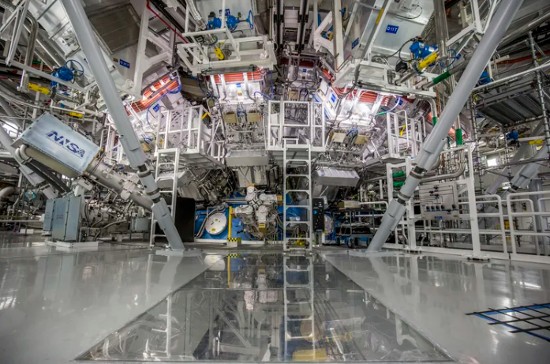As our year has wound to an end, the Lawrence Livermore National Laboratory has given the world a positive energy jolt by conducting a fusion energy experiment that ended with controlled ignition. A year earlier, a similar experiment at the Lab’s National Ignition Facility achieved 70% energy of output over input firing lasers at a BB-sized capsule containing hydrogen isotopes (deuterium and tritium).
The National Ignition Facility repeatedly tweaks and fires its lasers at a variety of designed nuclear-fuel-containing pellets, about once every four to eight hours. But on December 5th, the test produced a milestone with an energy yield greater than input. The experiment was considered so significant that it led to a spate of announcements from the White House and the U.S. Department of Energy and a press conference on December 13th in Washington, D.C. to announce the results to the world.
Dr. Arati Prabhakar, the U.S. President’s Chief Advisor for Science and Technology and Director of the White House Office of Science and Technology Policy attended the announcement where she described how back in 1978 when she first came to the Lawrence Livermore National Laboratory as a young woman, she first heard about using lasers to generate fusion energy.
Forty-four years later, this fundamental research she witnessed in its infancy finally started to pay off. Fusion ignition is a triumph of science and engineering. It represents the first step to producing unlimited nuclear energy here on Earth with no radioactive waste.
An issued press release described the output of the experiment which used 192 lasers and 2.05 Megajoules (MJ) of energy input, to create an ignition yield exceeding 3.15 MJs, a gain of 1.5. The single pulse took less time than it takes light to travel 2.54 centimetres (one inch).
The National Ignition Facility covers a space larger than three football fields. You can see just how massive it is in the picture appearing at the beginning of this article. The laser beams target tiny capsules of deuterium-tritium hydrogen isotopes firing once every four to eight hours. In the successful experiment, approximately 4% of the fuel was converted to energy. For commercial nuclear fusion that 1.5 number will have to grow by 50 to 100 times and the fusion ignition event rate will have to speed up to at least ten per minute.
Other Nuclear Fusion Options On The Table
Using lasers to generate fusion energy is one of a number of options nuclear scientists and engineers are working on today.
- Plasma-based nuclear fusion using magnetic confinement is by far where most of the research is being funded. The ITER project in Europe is just one of a number of projects that use a containment vessel called a tokamak to confine a plasma field to generate enough heat to induce a controlled fusion ignition.
- A German team at The Max-Planck Institute for Plasma Physics has been working with a confinement vessel called a stellarator which is described as a simpler solution than a tokamak.
- And General Fusion, a Canadian company is using a sphere of molten lead and lithium with a core containing deuterium-tritium fuel. Its technology is called Magnetized Target Fusion and includes an array of 300 pistons that apply pulsed pressure to the sphere to compress the contents within it to a point where controlled fusion ignition occurs. General Fusion’s novel design was recently given a boost with a contract to build a demonstrator power plant near Oxford, England with an opening date of 2025. It will be 70% to scale of what eventually could become the first working commercial fusion reactor.
So What’s Next?
The Lawrence Livermore achievement, however, represents the first positive energy yield from a fusion technology. These others still need to prove they too can create more energy output than the amount needed to achieve a controlled ignition.
One thing is for sure, with demonstrated fusion ignition the nuclear power industry has moved us one step closer to a secure clean energy future with a solution to support efforts to reverse the effects of fossil-fuel-energy sources on global climate. We cannot afford to wait several more decades for nuclear fusion energy to become mainstream. The stakes for the planet are too high. That’s why I expect renewed interest and billions of dollars more to be spent on commercial fusion power technologies.

















[…] Facility at Lawrence Livermore Laboratory in California announced that in a test it had achieved positive energy output from a controlled fusion experiment. A major press conference ensued in Washington with […]
[…] December of 2022, the Lawrence Livermore National Laboratory (LLNL) in California was the first to achieve ignition with an experiment that produced more energy than it took to get the fusion going. LLNL used 192 […]